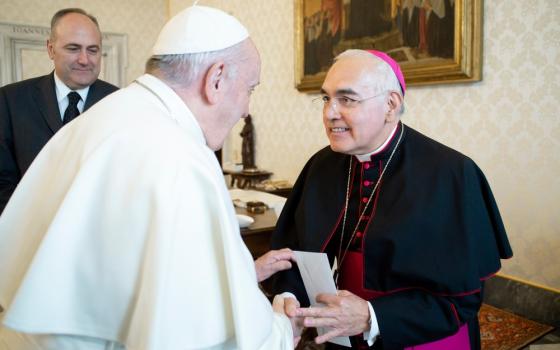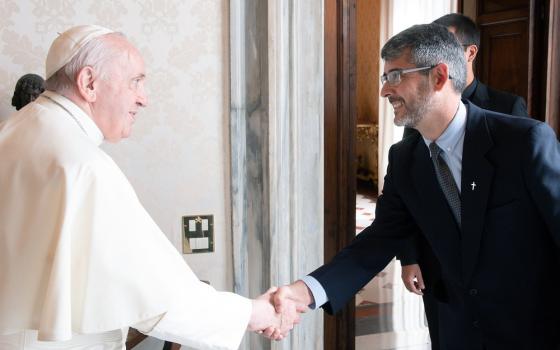
Analysis
In statements, speeches, interviews and at least one pastoral letter, bishops in various parts of the world have begun raising provocative questions about whether something intrinsic to the Roman Catholic church -- perhaps its clerical culture, its manner of governance, its exercise of authority, or a combination of such elements -- has either caused or abetted the priest sex abuse tragedy.
From South Africa to Australia, Austria to Ireland, prelates are suggesting that perhaps deeply ingrained habits that have become inherent to clerical and hierarchical behavior, yet are inimical to the message the church proclaims, have contributed to the depth and scope of the scandal.
In seeking to understand the crisis, the bishops have speculated on whether the scandal might be rooted in inadequate seminary training or in a “narrow clericalism” that placed priests above reproach. They wonder openly about the effects of church “triumphalism” and how leaders could have ignored the plight of children for so long.
Though the statements by individual bishops are not coordinated and have occurred in a variety of contexts, the questions they pose range over similar terrain, exploring it at different levels and degrees of formality. In each instance, the provocation for the introspection is the sexual abuse crisis in which thousands of priests worldwide have abused tens of thousands of children ranging in age from the very young to late teens.
The discussion that is emerging from church leaders in other parts of the world is markedly, and in some instances dramatically, different from the responses and analyses of the problem that have been advanced by bishops in the United States.
One of the more formal and extensive examinations was issued May 23 by Archbishop Mark Coleridge of Canberra and Goulburn, Australia, in a pastoral letter timed for Pentecost, titled “Seeing the Faces, Hearing the Voices: A Pentecost Letter on Sexual Abuse of the Young in the Catholic Church” (see story).
Coleridge declined an interview, responding in an e-mail that he invited reference to the letter, but that he had otherwise decided to allow the letter to speak for itself, adding, “For the moment I may have said enough.”
Coleridge’s pastoral outlines how his awareness of the problem grew -- from meeting with and listening to victims, to reading transcripts of trials and working in the Vatican. That awareness eventually led him to a point of view that at first he had rejected, that priest abuse of children was “cultural rather than merely personal, at least in the Australian situation.”
“I came to think that the problem was in some way cultural, but that prompted the further question of how; what was it that allowed this canker to grow in the body of the Catholic church, not just here and there but more broadly? I would part company with some answers to this question, because they seem to me ill-informed, one-dimensional or ideologically driven. There is no one factor that makes abuse of the young by Catholic clergy in some sense cultural. It seems to me rather a complex combination of factors which I do not claim to understand fully, even if I now understand more than I did.”
Among the elements Coleridge listed that may have contributed to the culture that allowed the crisis to fester and grow are:
- “Poor understanding and communication of the church’s teaching on sexuality, shown particularly in a rigorist attitude to the body and sexuality.”
- Clerical celibacy, while not itself a factor in Coleridge’s estimation, “may also have been attractive to men in whom there were pedophile tendencies which may not have been explicitly recognized by the men themselves when they entered the seminary.”
- “Certain forms of seminary training which failed to take proper account of human formation and promoted therefore a kind of institutionalized immaturity.”
- “Clericalism understood as a hierarchy of power, not service. ... It was a fruit of seminary training that was inadequate at certain points, and it is almost inevitable once the priesthood and preparation for it are not deeply grounded in the life of faith and discipleship.”
- “A certain triumphalism in the Catholic church, a kind of institutional pride, was a further factor. There is much in the Catholic church, her culture and tradition about which one can be justifiably proud. ... But there can be a dark side to this which leads to a determination to protect the reputation of the church at all costs.”
- “The church’s culture of forgiveness, which tends to view things in terms of sin and forgiveness rather than crime and punishment.”
- A “culture of discretion” that “turned dark when it was used to conceal crime and to protect the reputation of the church or the image of the priesthood in a country that has never known the virulent anticlericalism of elsewhere.”
Others speak out
While Coleridge had the opportunity to watch the scandal unfold from several vantage points -- he spent several years working at the Vatican’s Secretariat of State before being appointed a bishop in 2002 -- others caught in the crossfire of the controversy have also issued strong, if much briefer, statements.
Bishop Donal McKeown, auxiliary bishop of Down and Connor in Ireland, commented following the release of the government report on sex abuse in the Dublin archdiocese: “What I am looking forward to is the church in Ireland seriously taking on that agenda [for reform], committing itself to a process that will develop us into a church that is transparent, that is open and accountable.”
 Bishop Willie Walsh of Killaloe, in advocating for reform, told The Irish News, “If some structures which we have put up over the years and over the centuries have to be taken down, then so be it.”
Bishop Willie Walsh of Killaloe, in advocating for reform, told The Irish News, “If some structures which we have put up over the years and over the centuries have to be taken down, then so be it.”
In an April 22 statement, Irish Bishop Jim Moriarty of Kildare and Leighlin said he was announcing his resignation because he had been part of the governance of the Dublin archdiocese “prior to when correct child protection policies and procedures were implemented. Again, I accept that from the time I became an auxiliary bishop, I should have challenged the prevailing culture.
“The truth is,” he said, “that the long struggle of survivors to be heard and respected by church authorities has revealed a culture within the church that many would simply describe as unchristian. People do not recognize the gentle, endless love of the Lord in narrow interpretations of responsibility and a basic lack of compassion and humility.”
In late April, in what one informed Vatican observer termed “a rare breach of normal etiquette at senior levels of the church” Austria’s Cardinal Cristoph Schönborn accused another cardinal, Angelo Sodano, of complicity in the cover-up of sexual abuse allegations against Schönborn’s predecessor.
During an interview with Austrian journalists, Schönborn said Sodano, during his tenure as Vatican secretary of state in the 1990s, blocked an investigation of former Vienna Cardinal Hans Hermann Groër. After the charges became public, a group of Austrian bishops announced they were “morally certain” that Groër, who died in 2003, had been guilty of abusing former novice monks at the Benedictine abbey where Groër once served as abbot.
During the April interview, Schönborn reportedly also declared that “the days of cover-up are over.”
More recently, Bishop Kevin Dowling of Rustenburg, South Africa, delivered a stinging critique of how power is exercised in the church today during a talk to a group of concerned Catholics. The full text of the talk was published in the July 23 issue of NCR and is also available at NCRonline.org (see story).
He said that recent shows of church triumphalism -- in the case he cited, the use of the elaborate robe called a “cappa magna” -- is unfortunate “in a church torn apart by the sexual abuse scandal.” He argued that such displays are symbolic of an ongoing “restorationism” in the church, an attempt to return to the kind of centralized power structure that existed before the reforms of the 1960s Second Vatican Council.
Martin seeks reform
The term “culture” appears in many of the analyses. It is never precisely defined, but often used in a way that assumes Catholics understand its meaning.
An example is contained in the statement issued by the Irish bishops, from their December 2009 conference, responding to the evidence of widespread abuse and cover-up detailed in the Murphy Report, the result of a government investigation into the Dublin archdiocese: “We are shamed by the extent to which child sexual abuse was covered up in the archdiocese of Dublin and recognize that this indicates a culture that was widespread in the church. The avoidance of scandal, the preservation of the reputations of individuals and of the church, took precedence over the safety and welfare of children.”
 Archbishop Diarmuid Martin, a Vatican official much of his career who was appointed to Dublin in 2004, has been an unusually forceful advocate of full disclosure. He has also sought, behind the scenes, the resignation of a number of Irish bishops, including two of his own auxiliaries who were implicated in past cover-ups. The two submitted their resignations to Rome at the end of last year, but the Vatican has recently refused to accept the resignations (see story).
Archbishop Diarmuid Martin, a Vatican official much of his career who was appointed to Dublin in 2004, has been an unusually forceful advocate of full disclosure. He has also sought, behind the scenes, the resignation of a number of Irish bishops, including two of his own auxiliaries who were implicated in past cover-ups. The two submitted their resignations to Rome at the end of last year, but the Vatican has recently refused to accept the resignations (see story).
In March, following release of the Dublin report, Martin told The Associated Press that his colleagues in the Irish hierarchy “must tell ‘the entire truth’ ” about decades of church cover-up of abuse or face broader investigations by the government.
Martin willingly handed over as many as 60,000 pages of documents related to abuse and cover-up. In an interview on Irish television he said he had read many of them over a weekend and at one point became so disgusted that he threw them to the floor.
In the wake of those revelations, Martin has emphasized both priest training and formation of laity for pastoral work. He said at one point that he was working on plans to have seminarians, prospective deacons, and laity training to be pastoral workers “share some sections of their studies together, in order to create a better culture of collaborative ministry. The narrow culture of clericalism has to be eliminated.”
In that same May 10 talk to a Catholic group, Martin expressed discouragement at the reluctance within the church to undertake “a painful process of renewal.”
While expressing optimism that ultimately the future of the church would be guided by the Holy Spirit, he said that on a personal level, “I have never felt so disheartened and discouraged about the level of willingness to really begin what is going to be a painful path of renewal and of what is involved in that renewal.”
In this talk and other statements, Martin is not specific about the practical steps he might envision in that renewal. Perhaps he stays away from specifics because raising the specter of renewal in such terms can also raise a host of complications. While he believes the future of the church in Ireland “will see a very different Catholic church,” he said he worries “when I hear those with institutional responsibility stress the role of the institution, and others then in reaction saying that ‘we are the church.’ Perhaps on both sides there may be an underlying feeling that ‘I am the church,’ that the church must be modeled on my way of thinking or on my position. Renewal is never our own creation. Renewal will only come through returning to the church which we have received from the Lord.”
But before any renewal can occur, people have to be aware of the need for it, and Martin lamented “the drip-by-drip, never-ending revelation about child sexual abuse and the disastrous way it was handled. There are still strong forces which would prefer that the truth did not emerge. ... There are signs of subconscious denial on the part of many about the extent of the abuse which occurred ... and how it was covered up. There are other signs of rejection of a sense of responsibility for what had happened.”
Different response in US
To the ears of U.S. Catholics, the candor of Coleridge and Martin, especially the latter’s cooperation with civil authorities, would ring as a starkly different approach than that taken by most U.S. prelates. But the assessments of the several government investigations that have been conducted into the activities of various dioceses in Ireland are strikingly similar to those made by the few grand juries and the National Review Board appointed by the U.S. bishops in the wake of the explosive revelations in 2002 about sex abuse and the church cover-up over decades in the Boston archdiocese. The conclusions are in agreement about fundamental points: The church failed to report crime to civil authorities and in most instances acted to protect the interests of the institution and the priesthood rather than act in the best interest of those abused.
In the United States, bishops argued when the first cases of sexual abuse and cover-up were revealed in the mid-1980s that they didn’t understand the illness, that in reassigning priests they were acting on the best advice of psychologists and psychiatrists. Later, some of the loudest defenders of the actions of the hierarchy argued that the media was blowing the scandal out of proportion, or that the church, unlike other secular institutions, was being unfairly targeted by lawyers who foresaw big paydays for their clients in settlements of civil lawsuits.
That defensive posture was evident in the analysis of Cardinal Francis George of Chicago, president of the U.S. Conference of Catholic Bishops, in a section of his 2009 book, The Difference God Makes: A Catholic Vision of Faith, Communion, and Culture. “The priestly sex abuse scandal has been transformed into a scandal of church leadership, of church authority,” he writes. “Deservedly so, for bishops have failed, but also deliberately so,” he adds, placing the blame for the shift largely on the “opinion columns in The New York Times.”
“Priestly abuse of children and young people is a great tragedy of unbounded proportions and bishops must take responsibility for it; but it is also an occasion to unleash the anti-Catholicism that has never been far beneath the surface in U.S. history. For some, the only safe Catholic, the only good Catholic, is a Catholic who is at odds with the bishops.” He then castigates “self-styled prophetic voices in the church today” and characterizes them as “pro-abortion, pro-contraception, pro-divorce, pro-gay marriage -- pro any of the other items on the long list of sexual and culture freedoms claimed today. That is the voice of the dominant culture, and those who speak it receive their reward, at least in the opinion pages of The New York Times.”
Martin seems to reject such defenses when he writes that while sexual abuse of children by priests “constitutes only a small percentage of the sexual abuse of children in our society in general,” that fact “should never appear in any way as an attempt to downplay the gravity of what took place in the church of Christ. The church is different; the church is a place where children should be the subject of special protection and care. The Gospel presents children in a special light and reserves some of its most severe language for those who disregard or scandalize children in any way.”
Similarly, he turns on those who critique the church’s response in terms of public relations. “There are those who claim that the media strategy of the church in the archdiocese of Dublin following the publication of the Murphy Report was ‘catastrophic.’ My answer is that what the Murphy Report narrated was catastrophic and that the only honest reaction of the church was to publicly admit that the manner in which that catastrophe was addressed was spectacularly wrong; spectacularly wrong ‘full stop’; not spectacularly wrong, ‘but ...’ You cannot sound-bite your way out of a catastrophe.”
Conceding that sexual abuse of children may have been viewed differently in past eras, Martin nonetheless wonders how the church could have turned its back on children. “It is hard ... to understand why, in the management by church authorities of cases of the sexual abuse of children, the children themselves were for many years rarely even taken into the equation.”
[Tom Roberts is NCR editor at large. His e-mail address is troberts@ncronline.org.]
Stories in this series
|




